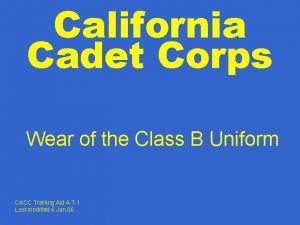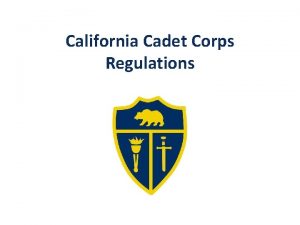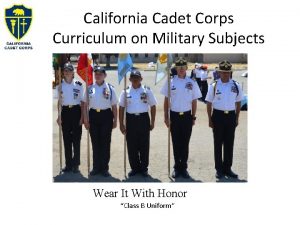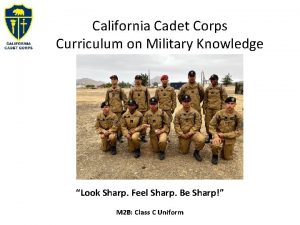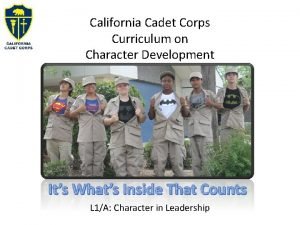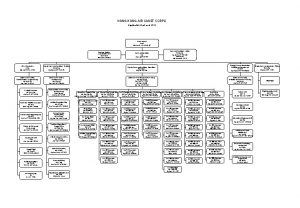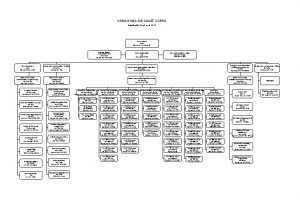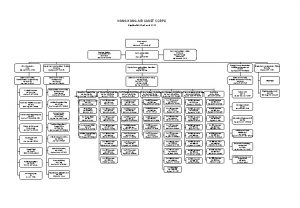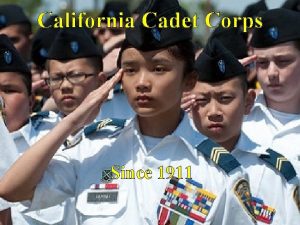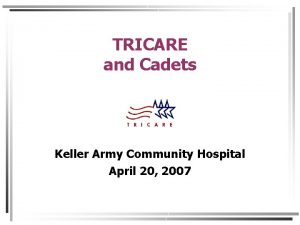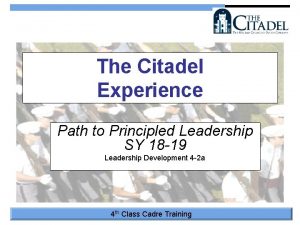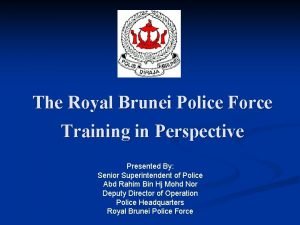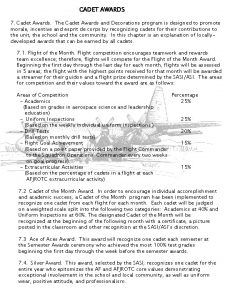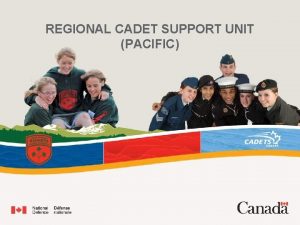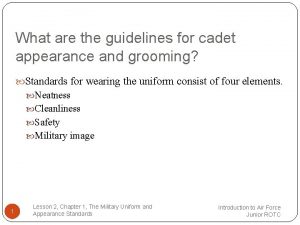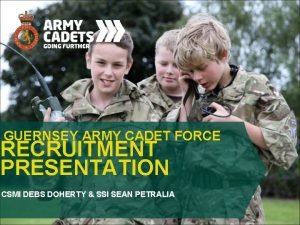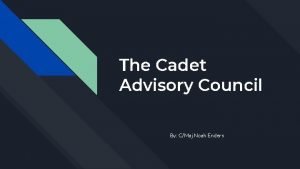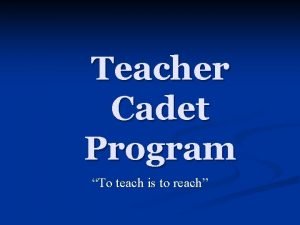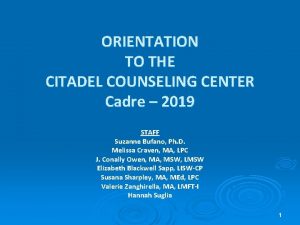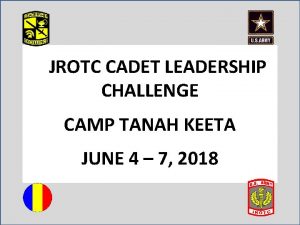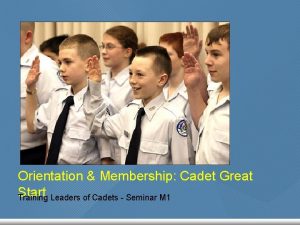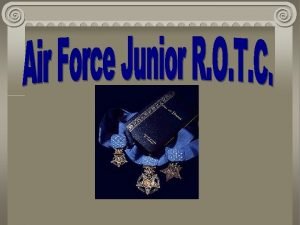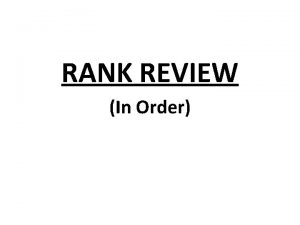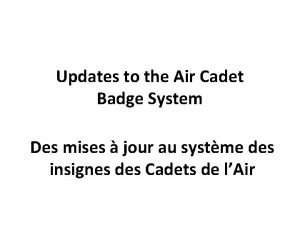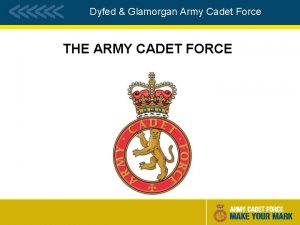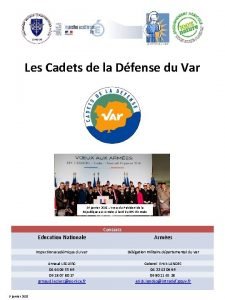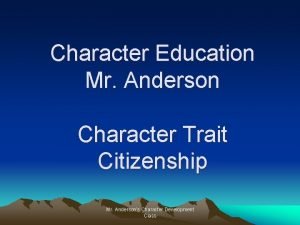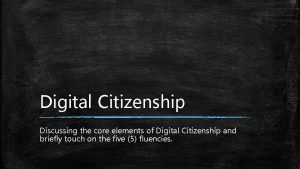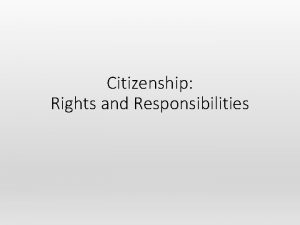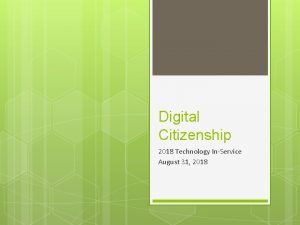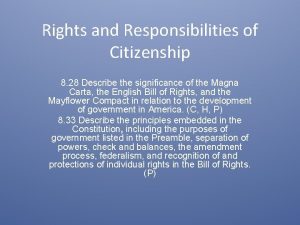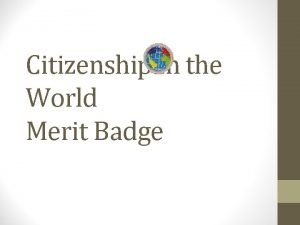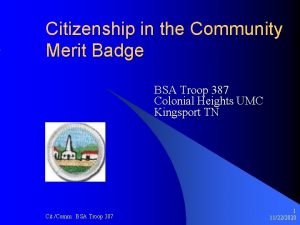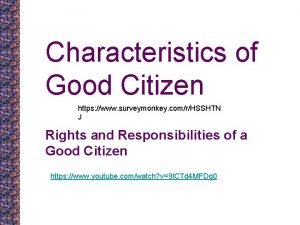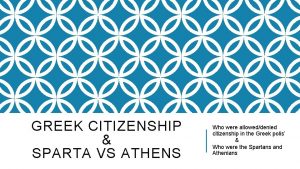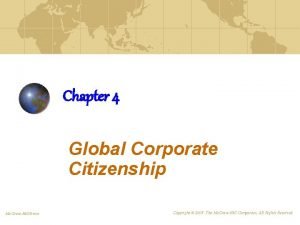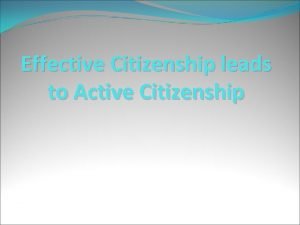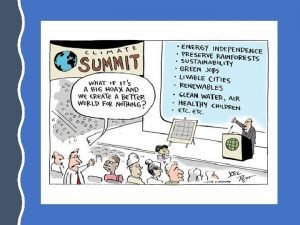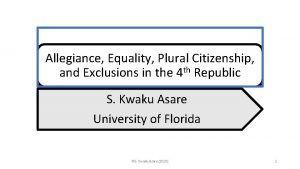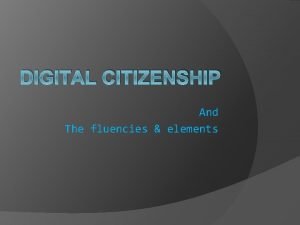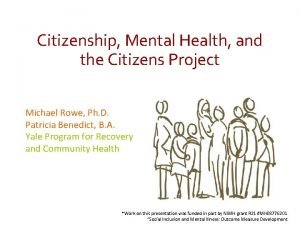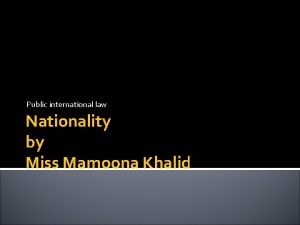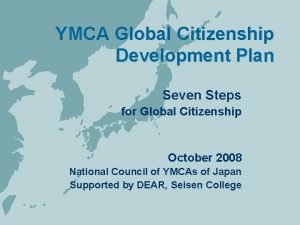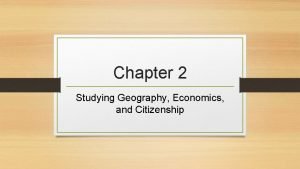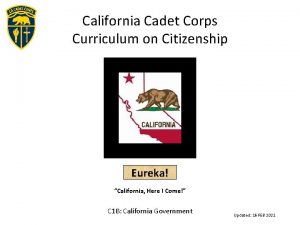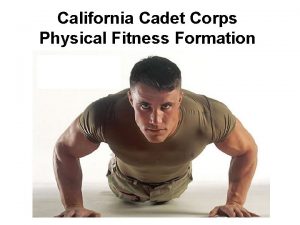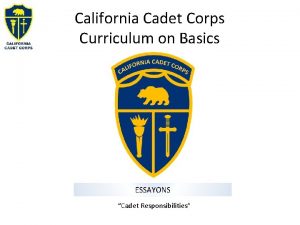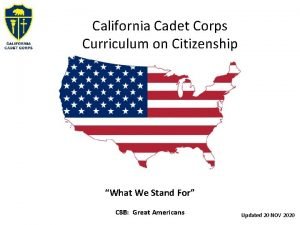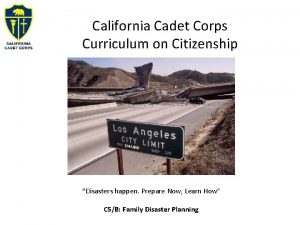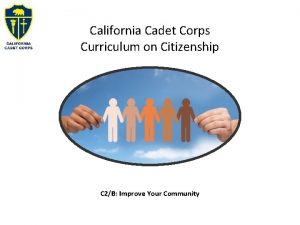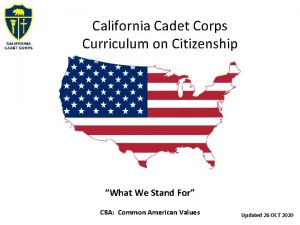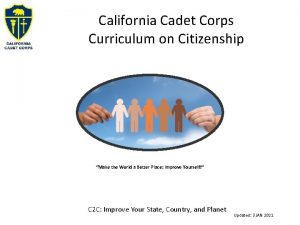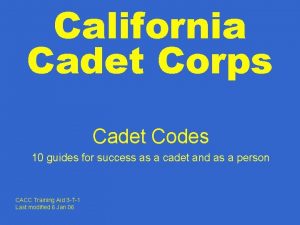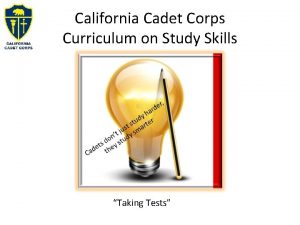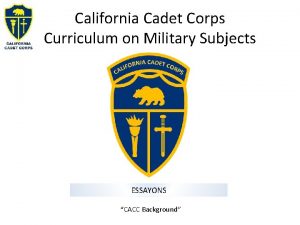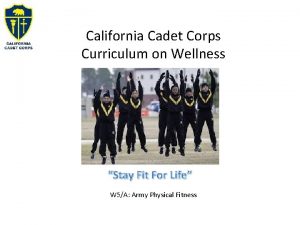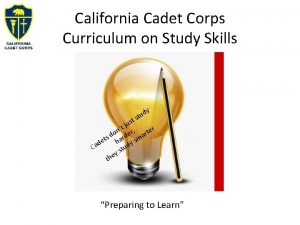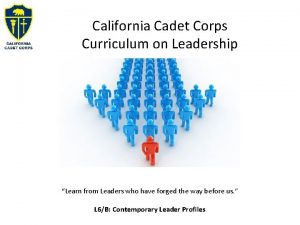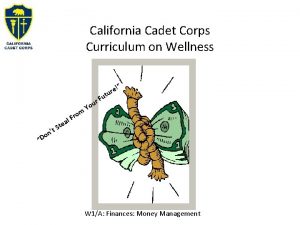California Cadet Corps Curriculum on Citizenship C 4A




![Diversity Defined diversity [di·ver·si·ty | də-ˈvər-sə-tē] NOUN 1 : the condition of having Diversity Defined diversity [di·ver·si·ty | də-ˈvər-sə-tē] NOUN 1 : the condition of having](https://slidetodoc.com/presentation_image_h/12ee88d5d88e50412e17feb52073f3ee/image-5.jpg)

































































- Slides: 70

California Cadet Corps Curriculum on Citizenship C 4/A: Understanding Diversity

Agenda A 1. Types of Diversity A 2. Gender & Sexual Diversity A 3. Age Diversity A 4. Race, Ethnicity, Culture, & Language Diversity A 5. Diversity in Philosophy and Politics A 6. Personality (True Colors)

TYPES OF DIVERSITY A 1. Define ‘diversity’ and discuss the difference between Identity Diversity, Value Diversity, Cognitive Diversity, and Behavioral Diversity.

Diversity OBJECTIVES Cadets understand support diversity within their Cadet Corps unit, school, and friendships. Plan of Action • Define ‘diversity’ and discuss the difference between Identity Diversity, Value Diversity, Cognitive Diversity, and Behavioral Diversity. Essential Question: What are the types of diversity and how do they interrelate?
![Diversity Defined diversity diversity dəˈvərsətē NOUN 1 the condition of having Diversity Defined diversity [di·ver·si·ty | də-ˈvər-sə-tē] NOUN 1 : the condition of having](https://slidetodoc.com/presentation_image_h/12ee88d5d88e50412e17feb52073f3ee/image-5.jpg)
Diversity Defined diversity [di·ver·si·ty | də-ˈvər-sə-tē] NOUN 1 : the condition of having or being composed of differing elements : VARIETY especially : the inclusion of different types of people (such as people of different races or cultures) in a group or organization programs intended to promote diversity in schools 2 : an instance of being composed of differing elements or qualities : an instance of being diverse a diversity of opinion Merriam-Webster

Types of Diversity • • Identity / Social Category / Demographic Value Cognitive / Informational Behavioral

Identity / Social Category / Demographic Diversity • Related to a person’s social-physical categories, like race, gender, ethnicity, sexual orientation, physical ability. • Refers to who we are, in our bodies • Often there’s a long history of discrimination being legitimized in law and customs • Often immediately visible, obvious, and “objective” – hard for a person to avoid • Can’t be changed by individuals themselves

Value Diversity • Related to diversity in belief systems, value preferences, assumptions about what is better or right, beliefs about how the world is organized. • Refers to what we believe. Includes religion & politics.

Cognitive / Informational Diversity • Related to what you know and how you know it, including work experience, learning styles, intelligence, differences in mental processes of perception, judgment, categorization, and so on. • Refers to what we know.

Behavioral Diversity • related to personality styles, action orientation, how we interact with others, working style. • Refers to how we act.

Types of Diversity Related • These four types of diversity are related, in that a person’s social category will influence his or her life experience, and thus influence his or her values, cognitive preferences, and behavioral preferences. • These types are not independent, and at the same time the relationships between them are not hard-wired.

Diversity & Inclusion • focuses mostly on oppressed groups – race, sex, ethnicity, gender identity, etc. – what their experience has been, and how to remedy that so all peoples’ experience is equitable. • Embrace differences • Everyone contributes to the group’s ability to accomplish the mission. Diverse ideas increase the likelihood of mission accomplishment

Oppression Olympics • A term used within social justice circles • Refers to arguments in which inequalities faced by a group are dismissed for being considered less important than those faced by another group • i. e. In feminist circles, some people push race related grievances, asserting their situation is worse than that for white women

CACC Core Value: Respect • Each of us, as human beings, deserve respect • If we can respect each other, we can work together to accomplish our common goals • Decreases conflict

Check on Learning 1. Match the type of diversity to a. Identity b. Value c. Cognitive / Informational d. Behavioral 1. How we act 2. What we know 3. Who we are 4. What we believe 2. Racial diversity is an example of what type of diversity? Identity Value Cognitive/Informational Behavioral 3. Religious diversity is an example of what type of diversity? Identity 1. Value 2. Cognitive/Informational 3. Behavioral

GENDER AND SEXUAL DIVERSITY A 2. Discuss an aspect of gender diversity that might affect you or your fellow cadets in the California Cadet Corps. A 3. List the categories of sexual diversity covered in this lesson, and give a brief definition of each.

Gender Diversity • Based on the ratio of male to female (and sometimes non-binary genders) • Usually refers to situations where there isn’t equality between the sexes • May refer to overall numbers, numbers within the leadership of an organization, representation on boards, etc.

Gender Diversity in CACC Sample Issues • Does the absence of many female commandants, or units that are mostly male, drive off potential female cadets? • How does the lack of gender diversity affect a unit? • Are leadership positions distributed evenly among male & female cadets

Practical Exercise • Collect information on your unit: – # of male cadets, # of female cadets in each rank – breakdown of M/F in leadership positions – look at types of positions by gender (i. e. are females assigned staff roles more predominantly than line leadership roles? • Determine the percentages • Assess the diversity of your unit, ID issues • Discuss ways to even the playing field

Sample Gender Diversity Issues • • • Unequal pay for the same work Glass ceilings – equal opportunity Positional bias Terminations School sports teams – Number of teams, funding, importance in school

Sample Gender Diversity Issues • • • Interview questions Task/role expectations Dress codes Office temperature settings Cheer squads

Gender Diversity • Studies show that companies with greater gender diversity more successful than those dominated by one gender • More success in production, financial responsibility, worker satisfaction, reputation, revenues, profits. • Similar success in gender diverse schools, military units, clubs

Sexual Diversity • The diversities of sex characteristics, sexual orientation, & gender identities • Physical Sex: based on an individual’s genitals • Assigned Sex: Declared at birth • Gender Identity: A person’s internal understanding of their own true gender

Sexual Diversity • Gender Role: Society’s belief of appropriate roles for males and females – Dress, behavior, activities – Which restroom to use • Gender Presentation: the way people express their gender/role outwardly, including: – Clothing, jewelry – Mannerisms – Hairstyle – Interests – Speech

Sexual Diversity • Perceived Gender: How someone appears to others. Think about how you ‘know’ someone is female or male • i. e. At first glance, many people see someone with short hair wearing a military uniform as male. This may have happened to cadets you know.

Sexual Diversity • What does this mean • Consider the distinctions between physical sex, assigned sex, gender identity, gender role, gender presentation, & perceived gender • How do you learn what’s considered appropriate for girls & boys? • How does someone else’s gender identity affect you?

Check on Learning 1. Johnny Smith makes more money than Peggy Jones. Is this gender inequality in pay? 2. Is a dress code gender biased? Why or why not? 3. What is the difference between physical sex and assigned sex?

AGE DIVERSITY A 4. List four ways Gen Z are different from Millennials

Age Diversity • • • Affects how you interact with others Discussed in terms of ‘generations’ May form cliques or social circles May disagree on how things should be done Open communication smoothes over differences

Advantages to Diversity • Age diversity has advantages: – Multiple ways of looking at issues – Problem solving – Creativity – Social awareness • And disadvantages – Tension between generations

Generation • “A group of people born around the same time and raised around the same place. ” • Generations exhibit similar characteristics because their experiences are similar – Communication, shopping, motivation preferences • Useful knowledge to people trying to reach, inform, or persuade a large cross-section of a population

Generations Generation Birth Dates Traditionalists or Silent Generation Born 1945 and before Baby Boomers Born 1946 -1964 Generation X Born 1965 -1976 Millennials or Generation Y Born 1977 -1995 Generation Z, (also known as i. Gen, or Centennials) Born 1996 -(2010 -2015)

From Millennials to Gen Z • For Millennials, 9 -11 was significant in their lives. For Gen Z, it wasn’t (they were too young) • Millennials show significant differences from their predecessors – Gen X • Different attitudes toward employment, sales, & marketing

Gen Z (i. Gen, Centennials) • The current ‘new’ generation • Different from predecessors in parenting, education, employment, entrepreneurship, sales, marketing, politics, religion and more • Your generation • You’ve never known life without the Internet

Millennials vs Gen Z Millennials Generation Z Raised by Baby Boomers Raised by Gen Xers Grew up during an economic boom Grew up during a recession Tend to be idealistic Tend to be pragmatic Focused on having experiences Focused on saving money Mobile pioneers Mobile natives Prefer brands that share their values Prefer brands that feel authentic Prefer Facebook and Instagram Prefer Snapchat and Instagram

‘True Gen’ • Baby Boomers (1946 -1964) – post World War II, consumption • Gen Xers (1965 -1976) – status • Millennials (1977 -1995) – experiences • Gen Z (1996 -2015) – search for truth • There’s not only one way to be • Greater freedom of expression, openness to understanding different kinds of people

Gen Z • Individuals shape their identities over time • Radical inclusiveness – connecting through different truths • Friends online & in real world are all friends • Technology friendly • Fewer confrontations – more dialogue • Flexible about differences of opinion within the institutions they connect with • Embrace diversity & inclusion

Check on Learning 1. Name three generations within our society today. 2. Someone born in 2010 is in which generation? 3. Match the generation to what defines them: a. Baby Boomers 1. Search for Truth b. Millennials 2. Love of consumption c. Gen Z 3. Search for experiences

RACE, ETHNICITY, CULTURE, & LANGUAGE DIVERSITY A 5. Contrast the culture you fall into with another culture that is present in your school.

Races Listed in Census • • • • White Black or African American Indian or Alaska Native Asian Indian Chinese Filipino Other Asian — (i. e. Hmong, Laotian, Thai, Pakistani, Cambodian, etc. ) Japanese Korean Vietnamese Native Hawaiian Guamanian or Chamorro Samoan Other Pacific Islander — (i. e. Fijian, Tongan, etc. )

5 Categories of Race RACE PERCENTAGE IN US (2010 Census) White 79. 96% Black or African American 12. 85% American Indian/Alaska Native 0. 97% Asian 4. 43% Hawaiian Native & Pacific Islander 0. 18%

Hispanic/Latino • An ethnicity, not a race • Ethnicity is defined as belonging to a group that has a common language, culture, and body of traditions. • Hispanic/Latino is the only ethnicity tracked by the US Census

Culture • The way people live at a particular time and place. • Defined by customs, art, social institutions, beliefs, and way of life • In California education, you study 4 cultures: Asian, African, Hispanic/Latino, & Middle Eastern

Why Study Cultures • The more you know about a culture to respect its characteristics, it helps you hate less, understand more, appreciate what they offer (foods, traditions, clothes, architecture, etc. ) and acknowledge that they have valid input in the issues you share. • A Cadet Corps core value is Respect. Learning about others helps you respect them.

Diversity in Language • Impacts in workplace, schools, etc. • We tend to exclude people from our circle if they don’t speak our language • Lack of common language can separate you from those around you • If languages are a part of your culture (in your school, neighborhood, etc. ), learn what you can so you can communicate with everyone

Race, Ethnicity, Culture, Language • These categories of diversity & inclusion are important because they’re obvious, and you can’t escape them (or cover them up) • They establish, to some extent, your ‘identity’ and social category • They offer an opportunity to blend different strengths into the best possible solution • They offer the problem of separating you from others who are different, breaking up teams, & causing discrimination

Check on Learning 1. Name 4 of the 5 US Census categories of race. 2. What is ethnicity? What is the only ethnicity tracked by the US Census? 3. What Cadet Corps core value relates to culture and diversity?

DIVERSITY IN PHILOSOPHY & POLITICS A 6. Select a religion or political belief, and contrast it with another religion or political belief. List or discuss some differences and similarities.

Philosophy & Politics • Diversity in cultural, spiritual, and political beliefs can sometimes pose a challenge in a diverse organization • Respect: Don’t impose your beliefs on others • Keep your personal beliefs independent of your organizational responsibilities & duties • Don’t talk religion or politics with people you don’t know well

Get to Know Others • It’s great to expose yourself to a wide range of beliefs & experiences that are different from yours • That’s why we study other cultures • It brings you closer to people who are different from you • It opens your mind to new ways of thinking and experiencing life

Check on Learning 1. Diversity teaches you to _____ other cultures and ways of thinking 2. What two categories should you avoid talking about with people you don’t know well? 3. Name something about your culture you could share with someone from outside it

PERSONALITY DIVERSITY COLORS) (TRUE A 7. Discover which personality group in True Colors you best fit, and describe your color type (per Lowry) and how you fit in the general population.

True Colors • A personality profiling system • Similar to the Myers-Briggs Type Indicator (MBTI)(Strand L 4, B 7) • A model for understanding yourself and others based on your personality temperament (biologically based aspect of personality). • It uses four colors to categorize personality types into temperaments. • It was developed by Don Lowry in 1978.

Four Colors Lowry’s system divides personality types into four colors: ØGreen: Independent Thinkers ØGold: Pragmatic Planners ØOrange: Action-oriented ØBlue: People-oriented

Take an Assessment • In the True Colors process, you prioritize pictures and descriptions of characteristics based on what you know about yourself, how you react to different situations, and how you approach others. A free version of this test is in our text. Take the test by prioritizing the concepts represented in each line, then add up the boxes representing each color as listed at the bottom.


Understanding Personality • Knowing someone’s personality traits helps you connect with them, figure out what’s important to them, what motivates them, & how they’ll react to different situations • It helps you as a leader, or as a boss, or as a coworker, or as an employee or subordinate

Four Types • Different in fundamental ways: Ø They want different things Ø They have different motives, needs, drives Ø They analyze, conceptualize, understand, and learn differently

Gold I am conventional. I am the pillar of strength and have high respect for authority. I like to establish and maintain policies, procedures, and schedules. I have a strong sense of right and wrong. I am naturally parental and dutiful. I do things that require organization, dependability, management, and detail. I need to be useful and to belong. I am the sensible, stable backbone of any group. I believe that work comes before play. I value home, family, status, security, and tradition. I seek relationships that help me ensure a predictable life. I am caring, concerned, and loyal. I show concern through the practical things I do.

Orange I am courageous. I act on a moment's notice. I see life as a roll of the dice, a game of chance. I need stimulation, freedom, and excitement. I am a natural leader, troubleshooter, and performer. I like to do things that require variety, results, and participation. I often enjoy using tools. I am competitive and bounce back quickly from defeat. I value action, resourcefulness, and courage. I am generous, charming, and impulsive. I show affection through physical contact.

Blue I am compassionate. I am always encouraging and supporting. I am a peacemaker, sensitive to the needs of others. I am a natural romantic. I like to do things that require caring, counseling, nurturing, and harmonizing. I have a strong desire to contribute and to help others lead more significant lives. I am poetic and often enjoy the arts. I value integrity and unity in relationships. I am enthusiastic, idealistic, communicative, and sympathetic. I express my feelings easily.

Green I am conceptual. I have an investigative mind, intrigued by questions like, "Which came first, the chicken or the egg? " I am an independent thinker, a natural nonconformist, and live life by my own standards. I like to do things that require vision, problem solving, strategy, ingenuity, design, and change. Once I have perfected an idea, I refer to move on to a new challenge. I value knowledge, intelligence, insight, and justice. I enjoy relationships with shared interests. I prefer to let my head rule my heart. I am cool, calm, and collected. I do not express my emotions easily.

Class Exercise • Separate into groups by true color • Hand out poster paper, markers, pencils, & some pieces of masking tape • As a group, design an amusement park in 1520 minutes, tape it on the wall, and be ready to explain it to the group

How Groups Think Is this what happened with your groups? Generally: ü The Gold’s are very detail orientated including parking lots. ü The Greens usually only use a pencil and use mostly text. ü The Oranges like to draw and use lots of color and are the most unrealistic of the groups. ü The Blues always remember comfort details like bathrooms, first aid, handicap parking and diaper changing areas.

Notes About Gold This personality accounts for 38% of the population. This group turns the lights on at work, makes the coffee, makes sure budget is intact – basically they get things done. Golds are the worker bees. Without golds, everything stops! They learn best by instruction and are the ones most likely to raise their hand even in college. Most church workers and community workers are golds. 80% of all elementary school teachers are also gold. However, this personality is a rotten risk taker; they like security. Golds often make lists and enjoy highlighters. They entrust schools, prefer laws (most police & judges are gold) and like structure within a family. They are the most family orientated of the four groups. Golds also make more money “totally” than any other group. Golds are the group most likely to organize their sock drawer. They like things to be neat and in order.

Notes About Orange This personality accounts for 36% of the population. Oranges do things quickly, but they usually turn out pretty well. The difference from a gold is that oranges always do it their own way. They are not known for following rules or established systems. Oranges are also very celebrative – they are the “party” group. When they set their minds to accomplish something, they really like doing it. This personality is also very hands-on physical. They like activity. They are experiential and generally prefer no restraints. Oranges are mostly in creative arts and due to the activity attribute, most physical education teachers are orange. Oranges are very competitive, spontaneous, risk takers, adventurous, happy and have a great sense of humor; they sincerely like to make people laugh. This group, like blues, are very giving, but are not looking for something in return or desiring a lasting relationship as a result of “giving” -- however, in life, they do want to see results. Oranges are especially considered an organized mess. Their desks are piles and seem senseless, yet they know where everything is.

Notes About Blue This personality accounts for 12 -14% of the population; 70% are woman. This personality is often referred to as the “Hallmarks” as these people are most likely to send a card to someone. They write cards and also appreciate getting cards. They are flexible, love people, focus well and like to serve. They give the most “strokes” and also need to receive the most strokes. Their goal is to be with people. They are very introspective and ask questions like “Who am I – Who am I really. ” This group buys into the True Colors testing results the most. Blues are the “catapults” – they see potential and motivate others. They can often be misunderstood for being nosey because they always want to know how a person is doing. They ask about a person’s family and they really want to know – it is not just chit-chat to them. They learn best by pleasing others. This personality lends itself to never having a lot of money because blues are always spending it on others. Blues usually need to go shopping with other blues. They want to connect.

Notes About Green This personality accounts for 12 -14% of the population. They love knowledge, research, solving problems, data, philosophy, solutions and blue prints. To this personality, there never is enough time or data; they always want more information. Members of this personality usually include: scientists, mid level to top management execs, and CEO’s; 80% of all professors are greens. A green professor loves when students argue or disagree with him. They love debate. They are, however, bored easily. Greens are good planners but not the best implementers; instead, greens like to develop the solutions or blue prints and allow others to complete the work; they set the vision. Greens often question everything; always asking: “why? ” They desire the best answers and are not easily satisfied with a solution. They find it hard to put closure on things. They will continue to prove it is the best one. This personality can multi-task well, but a green will be the personality most likely to lose the car keys or where they parked the car at the mall. Greens are highly introverted and only take calculated risks. They do not share their feelings or emotions easily with others.

True Colors • Shows us how to approach, communicate, educate and even discipline someone more effectively within their natural framework. • For example: – A student who is gold will respond better to guidelines than an orange. – A blue will respond better to an emotional plea while a green will expect rational and reasoning.

Check on Learning 1. True Colors differentiates people into types based on a) Rank b) Favorite color c) Personality d) Leadership style 2. Try matching color types to staff roles, and indicate your thought process. Some may be in a couple places, some may need a couple colors! S 1: S 2: S 3: S 4:
 California cadet corps uniform
California cadet corps uniform California cadet corps website
California cadet corps website Cacc ribbon chart
Cacc ribbon chart California cadet corps class c uniform
California cadet corps class c uniform California cadet corps class c uniform
California cadet corps class c uniform Ca character
Ca character Airport authority hong kong organisation chart
Airport authority hong kong organisation chart 507 sqn
507 sqn Hong kong air cadet corps
Hong kong air cadet corps Six cadet corps objectives
Six cadet corps objectives Ca preschool curriculum framework
Ca preschool curriculum framework Leading cadet principles of flight exam answers
Leading cadet principles of flight exam answers Mologne health clinic
Mologne health clinic Air cadet abuse
Air cadet abuse Cadet james pelosi
Cadet james pelosi Citadel pillars of strength
Citadel pillars of strength What is the purpose of liquid in the capsule of a compass?
What is the purpose of liquid in the capsule of a compass? Zodiac cadet aero 230
Zodiac cadet aero 230 Cadet captions
Cadet captions Cadet protection policy
Cadet protection policy Jrotc cadet appearance and grooming standards
Jrotc cadet appearance and grooming standards Cadet blue card
Cadet blue card Ranking system of brunei police
Ranking system of brunei police To be recognized as an “ace of aces” a cadet must
To be recognized as an “ace of aces” a cadet must Cmpd envision academy
Cmpd envision academy Cadet
Cadet Regional cadet support unit pacific
Regional cadet support unit pacific Cadet rule in navigation
Cadet rule in navigation Cadet appearance and grooming standards
Cadet appearance and grooming standards Values and standards of the acf
Values and standards of the acf Cadet advisory council
Cadet advisory council Nc teacher cadet program
Nc teacher cadet program Cadet automation systems
Cadet automation systems Cadet rule in navigation
Cadet rule in navigation The citadel counseling center
The citadel counseling center Tanah keeta summer camp
Tanah keeta summer camp Cadet great start
Cadet great start Cadet humanitarian award
Cadet humanitarian award Cadet private first class
Cadet private first class Cadet badge placement
Cadet badge placement Acf values and standards powerpoint
Acf values and standards powerpoint Cadet portfolio
Cadet portfolio Air cadet badges placement
Air cadet badges placement Beihang
Beihang Aerospace education foundation badge
Aerospace education foundation badge Cadet de la défense toulon
Cadet de la défense toulon Beihang
Beihang Halton police cadet
Halton police cadet Who must give way to balloons?
Who must give way to balloons? Citizenship character trait
Citizenship character trait Elements of digital citizenship
Elements of digital citizenship What is citizenship
What is citizenship Digital citizen
Digital citizen Describe citizenship
Describe citizenship Citizenship in the world merit badge
Citizenship in the world merit badge Citizenship in the community movies
Citizenship in the community movies Characteristics of good citizenship
Characteristics of good citizenship Spartan citizenship
Spartan citizenship Stages of corporate citizenship
Stages of corporate citizenship Community merit badge
Community merit badge The mail
The mail What is effective citizenship
What is effective citizenship Global citizenship education topics and learning objectives
Global citizenship education topics and learning objectives Cspe cba
Cspe cba Asare v attorney general dual citizenship
Asare v attorney general dual citizenship 9 elements of digital citizenship
9 elements of digital citizenship Mental health and citizenship
Mental health and citizenship Global citizenship framework
Global citizenship framework Nationality vs citizenship
Nationality vs citizenship Global citizenship definition
Global citizenship definition Studying geography economics and citizenship
Studying geography economics and citizenship
